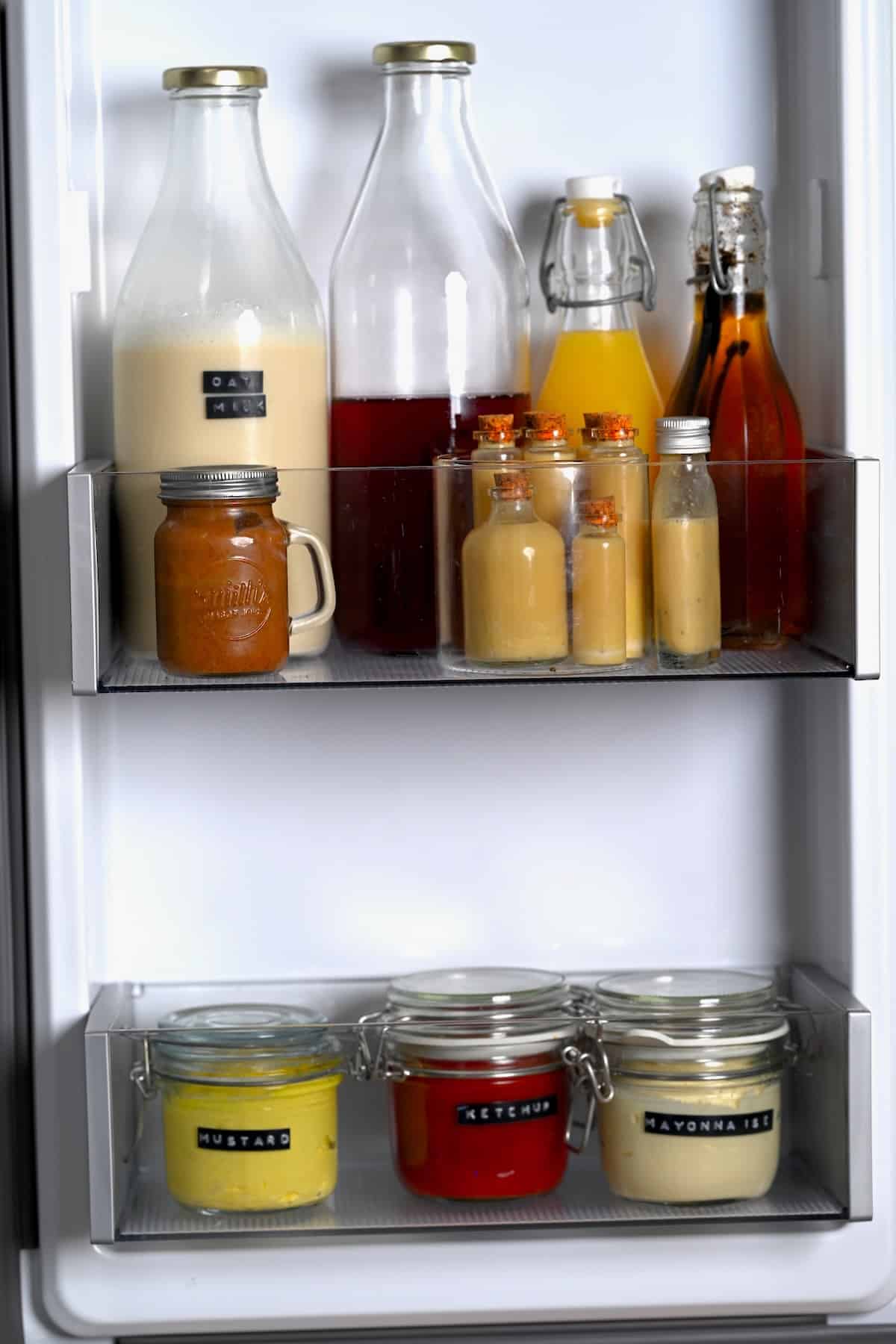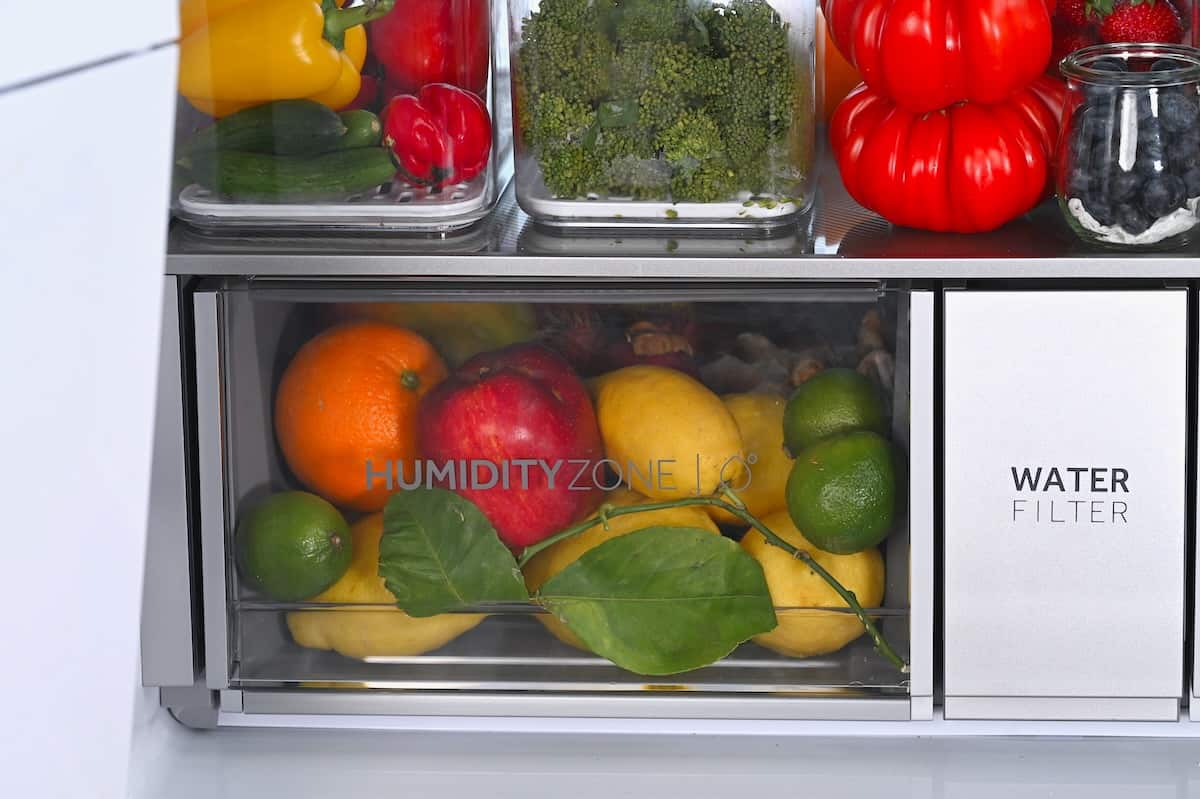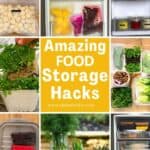This post may contain affiliate links. Please read our disclosure policy.
Top fridge organization ideas to make the most of space and reduce food waste! An organized fridge will keep your food fresh and your fridge clean!

Learning how to organize your fridge (the right way) is necessary for anyone wanting to make the most of the space available and reduce food wastage. The below guide will give you all the information needed to create a Pinterest worthy well-organized fridge!
Whether you’re storing items incorrectly, in the wrong places, or allow things to get pushed to the back of the refrigerator and be forgotten about (which causes wastage or ends up in you purchasing doubles of items), all of these issues can be solved with the following fridge organization ideas!
These are all DIY fridge organization hacks that I use and find work well for me (but definitely not the only way to do things) for the most functional, smart, and best use of the space.
Want to utilize the best storage and waste reduction methods throughout your kitchen? Stay tuned for my guide on how to organize your pantry and how to store fruits and vegetables properly! Coming soon!

What’s Included in This Post
How Do I Start Organizing a Fridge
Here are my top tips for organizing a fridge.
Before using any of the below refrigerator organization ideas, I recommend giving the refrigerator a good clean. Remove all the shelves and drawers and wash them in hot, soapy water. Store perishable items in a cooler while you do so.
If you have any lingering smells in the refrigerator, place a baking sheet with a thin layer of baking soda (or coffee grounds/oats) into the fridge to help absorb odors. A bowl of white vinegar also works well.
1) Do a Weekly Clean-Out/Start a Fridge Inventory
This might sound like a lot of work. However, if you use a fridge “inventory” (also called a fridge organization chart), you often won’t need to clear it out for months.
To create an inventory, I recommend using a magnetic whiteboard to stick to the front of your fridge (or writing directly on the fridge door with a dry erase marker).
- First, remove any spoiled items or items you’re unlikely to use.
- Then, make a list of everything remaining in your fridge along with their expiration dates. Use best-by dates as a general guideline only, as many items will last far beyond these dates.
I also recommend labeling open jars and items that, once opened, have a limited shelf life. Or add the item to your inventory and you’re good to go!
As you use items, erase them from your inventory. When you add to your fridge, add to the inventory. This is a great fridge organization idea for tracking what you have and what needs to be eaten to help reduce waste.
2) Use Clear Containers and Bins
Fridge containers will help you group items so nothing gets lost in your newly organized refrigerator. For example, I like to store all my cheese together. Many parents use fridge bins to store grab-and-go snacks for the kids, use one just for dips and condiments that don’t fit in the refrigerator doors, etc.
I like to remove packaging from items, too, and store them in my own fridge storage bins, bags, beeswax wrap, airtight glass containers, stasher bags/reusable silicone bags, etc. This saves space and makes things easier to find.

When storing individual items, I love using stackable ball glass jars and containers. Label the various refrigerator organizer bins and containers, too, so you always know what is there.
You could also use a lazy Susan for the back of your fridge shelves to easily reach all items.
3) Adjust Your Shelves
If you start placing the same items/storage containers in the same places each week, adjusting your shelves to fit these will make the most of your refrigerator space. For example, the shelf I use for dairy and eggs is much smaller than the one I use for fresh produce.
It can also help to purchase stackable containers that make the most of the vertical space in your refrigerator. Though you can get creative with what you have at hand.
4) Use Shelf Liners
Shelf liners are amazing for fridge clean-up. You can purchase them as ready-made size refrigerator mats or as “cut to size” options. Either way, if there are any spills or messes, you can just lift out the liner and wipe it off. Voila!
Other Refrigerator Organization Tips
- Use glass containers: Not only does this reduce plastic usage, but glass absorbs and holds the cold (and odors) better to help maintain consistent temperatures.
- Storing leftovers: I like to place any “must eat soon” items front and center of the shelf, so I see them every time I open the door. This helps to reduce waste, as it doesn’t get lost at the back of the fridge.
- Cool then refrigerate: From a food safety perspective, it’s best to refrigerate foods within two hours of cooking them. However, it’s also important to allow them to cool first so they don’t affect the temperature of the surrounding items and cause the refrigerator to work harder.
- Storing prepped fruits and veggies: Keep pre-chopped produce in airtight containers (either mason jars or reusable silicone food bags) to maintain their freshness for longer and avoid them absorbing odors from the surrounding items.
- Don’t overfill your fridge: Otherwise, it can restrict airflow and make it harder to keep items cool and at the correct temperature. Not to mention it affects the energy efficiency, too.

In terms of efficient food storage, it’s also important to ensure that your refrigerator/freezer temperatures are correct. Using an internal thermometer is a great way to make sure all is okay.
How to Organize a Fridge
The below fridge organization ideas make the most of every refrigerator section for optimal shelf life and function.
The Top Shelf
The upper shelves in your refrigerator have the most consistent temperatures and are great for storing pre-cooked foods.
- Leftovers
- Ready-to-eat foods
- Deli meats/fish

I also find this the perfect place for my meal prepped overnight oats and pre-chopped salads. I like to store already cooked food in shallow containers.
If you are interested in learning more about meal prepping, check my Essential Guide to Meal Prep + Meal Prep Ideas.
The Middle Shelves
Towards the middle of your refrigerator, I recommend storing items that do well with consistent, cold temperatures.
- Milk
- Cream
- Cheese (stored together in a food “bin”)
- Butter (this will store in the doors, too, as it doesn’t require consistent temperatures)
- Yogurt
- Eggs
- Cold drinks

I often use these shelves to store fresh herbs and delicate fruits, like berries. As they spoil quickly, the consistent temperatures are great for making the most of their shelf life.
The Lower Shelf
The lower shelves in your refrigerator are great for the produce spillover from your crisper drawers. I never find the drawers large enough to contain all the fruit and veggies I’ve bought (more info in the drawer section). I also store my herbs on these shelves.
Keep any delicate salad veggies and herbs away from the very back of the fridge, as they can cause them to wilt, especially if you have an issue with an icy back of the fridge (which lots of older models seem to struggle with).

The Bottom Shelf
Reserve the bottom shelf in your refrigerator for all raw meat and seafood as it’s the coldest part of your refrigerator and has consistent temperatures. It will also reduce the risk of cross-contamination from any dripping meat/fish.
Be careful not to overcrowd this shelf, so the cool air can flow easily around the perishable meats.
If you don’t consume meat/fish, you can use this shelf for any meat alternatives, tofu, and produce spillover.
The Fridge Doors
The fridge doors are the warmest part of your fridge and are subject to constant temperature fluctuations as they’re opened and closed multiple times throughout the day. For that reason, you may be surprised at what you should (and shouldn’t!) store in fridge doors.
- Condiments (ketchup, mayo, mustard, hot sauce, etc.),
- Bottled water and soft drinks,
- Salad dressings,
- Pickled foods,
- Butter and spreads (these actually don’t require constant cold temperature),
- Homemade nut butters and nut/grain flours (if you store them in the refrigerator).

Foods You Should Never Store in the Fridge Doors
There are certain foods you should avoid storing in the refrigerator doors because of the constant temperature fluctuations. These include dairy milk (I was surprised too!), eggs, meat, and fruits and vegetables. HOWEVER, check your refrigerator manual as mine promises to be “dairy friendly,” which can change your fridge organization.
Crisper Drawers
American-style fridge freezers often have a dedicated high-humidity and low-humidity drawer (some even allow you to input your own humidity settings). Other refrigerator models simply contain drawers with no particular benefits. Either way, though, these drawers are best for your fresh produce (veggies and fruits) that require refrigeration, including:
- Asparagus
- Apples
- Avocado (once ripe)
- Beans (green, runner, broad, etc.)
- Beets
- Berries (strawberry, blueberry, raspberry, cherries, etc.)
- Carrots
To make the most of the carrots’ shelf life, store them in a container submerged with water, changing the water every few days. This should keep them fresh for up to a month.
- Celery
- Cucumber
- Eggplant
- Grapefruit
- Leeks
- Lemons/limes
- Leafy greens (lettuce, spinach, kale, other salad greens, etc.)
- Mushrooms
- Parsnips (and other root veggies like turnips)
- Peppers (bell peppers, chilies)
- Pineapple
- Rhubarb
- Watermelon (and other melon)
- Zucchini (and summer squash)

I usually use one drawer for veggies and one for fruits, with the remaining veggies going on the lower shelves in the refrigerator. If you have humidity-controlled drawers, store ethylene-producing produce in the low-humidity drawer. Leafy greens and ethylene-sensitive items will work well in the high humidity drawer.
Where Should Drinks Go in the Fridge?
Dairy-based drinks (milk, hot chocolate, flavored yogurt drinks, lassi, etc) should be placed on the middle shelf. It’s best to place them on the side where cold air blows. Other cold drinks can be placed on the side.
Drinks with preservatives can be placed on the doors. These include soft drinks (fizzy drinks), fruit juices, wine, etc. Water can be placed on the doors, too.
What Produce Doesn’t Need Refrigerating?
- Bananas (they’ll brown quicker in the fridge).
- Onions (store separated and hung up in tights for months of storage).
- Potatoes (regular, sweet potatoes, etc.; store them in a brown bag with an apple or two to keep them from sprouting).
- Tomatoes (unless ripe and soft).
- Winter squash (butternut, acorn, spaghetti).
- Pumpkin.
There are also some items you can store at room temperature if you plan to eat them within a day or two or store them in the refrigerator to extend their shelf life by a few days. However, refer to my guide on fruit and vegetable storage (coming soon!) to learn the proper storage methods for all your favorite produce along with top tips to extend their shelf lives.
How To Separate Fruits and Veggies
The other primary consideration (aside from where to store them) when storing fresh produce is to ensure that you store ethylene-producing and ethylene-sensitive produce apart to avoid shortening shelf lives.

Ethylene-producing
- Apricots
- Apples
- Avocados (don’t refrigerate till ripe)
- Bananas (don’t refrigerate)
- Cantaloupe & Honeydew Melons
- Kiwis
- Mangoes
- Nectarines (don’t refrigerate)
- Papayas
- Peaches (don’t refrigerate)
- Pears (don’t refrigerate)
- Plums (don’t refrigerate)
- Tomatoes (don’t refrigerate)
Ethylene-sensitive
- Asparagus
- Berries
- Cruciferous vegetables (i.e., arugula, bok choy, broccoli, Brussel sprouts, cabbage, cauliflower, collard greens, kale, etc.)
- Carrots
- Cucumbers
- Eggplants
- Green beans
- Lettuce and other greens
- Leeks
- Potatoes
- Peppers
- Peas
- Squash
- Watermelon
How to Store Soft Herbs and Leafy Greens?
For herbs: Trim the ends and place the herbs in glass jars with a bit of water (like a bouquet of flowers). Swap out the water every 2-3 days. This should keep them fresh for up to 2 weeks. Alternatively, wrap them in a damp paper towel and store them in a resealable freezer bag/container.
To store your leafy veggies: Wash them well and use a salad spinner (or paper towels) to dry them thoroughly. Then store in containers lined with dry paper towels. Swap out the paper towels every few days.

Food Storage Hack: If you notice your lettuce going limp, you can rehydrate it by tossing it into a container with some iced water for up to half an hour to bring life back into it in time for dinner.
Leafy stemmed veg like Kale & Chard (also celery and asparagus) can be kept in glass jars with a little water to stay fresh for 2-3 weeks. Change the water every few days!
BONUS: Freezer Organization Ideas
Along with the refrigerator organization ideas, here are some ideas for how to organize your freezer.
- Use storage bins for your freezer to separate types of food (veggies, meat, desserts, etc.).
- Portion items for easier thawing (i.e., prepare portions of veggies or meat in separate containers).
- Store any prepared produce in freezer bags or airtight, stackable containers.
- Store items vertically instead of flat to make the most of the space.

More Easy Guides
- How to Organize a Pantry
- How to Store Fruits and Vegetables To Last as Long and Possible
- A Step-by-Step Guide to Water Bath Canning for Beginners
- How to Paint a Refrigerator (Low-budget Retro Refrigerator)
- DIY: Clean A Microwave With Lemon (Clean Microwave Hack)
- The Best Kitchen Tools I Can’t Live Without (And Some That I can!)
- January Produce and Recipes
- What’s in Season – February Produce and Recipes



If you try any of these fridge organization ideas/hacks, I’d love to hear your thoughts/questions below. Also, I’d appreciate a recipe card rating below, and feel free to tag me in your recipe recreations on Instagram @Alphafoodie!

Guide to Fridge Organization, Ideas and Tips
Equipment
Instructions
Top Tips For Organizing a Fridge
- Do a weekly clean-out/start a fridge inventory:– Remove any spoiled items or items you're unlikely to use.– Make a list of everything remaining in your fridge along with their expiration dates. – As you use items, erase them from your inventory. When you add to your fridge, add to the inventory. In this way, you track what you have and what needs to be eaten.
- Use clear containers and bins: Fridge containers will help you group items so nothing gets lost in your newly organized fridge. Remove packaging from items and store them in food storage bins, bags, beeswax wrap, airtight glass containers, stasher bags/reusable silicone bags, etc. This saves space and makes things easier to find. When storing individual items, use stackable ball glass jars and containers. Label the various organizer bins and containers, too, so you always know what is there.
- Adjust your shelves: If you start placing the same items/storage containers in the same places each week, adjusting your shelves to fit these will make the most of your refrigerator space. For example, the shelf I use for dairy and eggs is much smaller than the one I use for fresh produce.
- Use shelf liners: Shelf liners are amazing for fridge clean-up. If there are any spills or messes, you can just lift out the liner and wipe it off.
How to Organize a Fridge
- Top Shelf: The upper shelves have the most consistent temperatures and are great for storing pre-cooked foods.– Leftovers & meal prepped dishes– Ready-to-eat foods– Deli meats/fish
- The Middle Shelves: Store items that do well with consistent, cold temperatures.– Milk, cream, cheese (stored together in a food "bin"), butter (this will store in the doors, too, as it doesn't require consistent temperatures), yogurt, eggs, cold drink, etc.
- The Lower Shelf: The lower shelves are great for the produce spillover from your crisper drawers.
- The Bottom Shelf: Reserve the bottom shelf for all raw meat and seafood as it's the coldest part of your refrigerator and has consistent temperatures. It will also reduce the risk of cross-contamination from any dripping meat/fish.
- The Doors: The fridge doors are the warmest part of your fridge and are subject to constant temperature fluctuations as they're opened and closed multiple times throughout the day. Keep:– Condiments (ketchup, mayo, mustard, hot sauce, etc.)– Bottled water and soft drinks– Salad dressings and pickled foods– Butter and spreads (these actually don't require constant cold temperature)– Homemade nut butters and nut flours (if you store them in the refrigerator)
- Crisper Drawers: the drawers are best for your fresh produce (veggies and fruits) that require refrigeration. Check the blog post for a complete list.
Notes
- Use storage bins for your freezer to separate types of food (veggies, meat, desserts, etc.).
- Portion items for easier thawing (i.e., prepare portions of veggies or meat in separate containers).
- Store any prepared produce in freezer bags or airtight, stackable containers.
- Store items vertically instead of flat to make the most of the space.


















